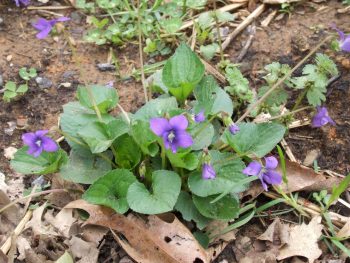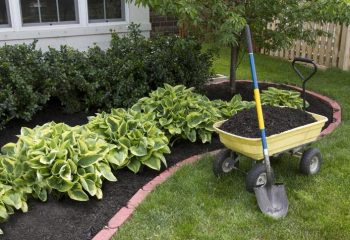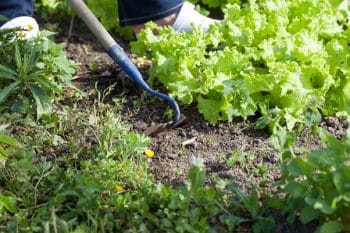How To Clear Weeds From Flower Bed
Methods To Fixing A Weed Problem
 How can you fix a flower bed full of weeds in your garden? You can spend a few weeks tearing them out of the ground, but most will likely grow weary of this chore.
How can you fix a flower bed full of weeds in your garden? You can spend a few weeks tearing them out of the ground, but most will likely grow weary of this chore.
Don't get too worked up about. A few simple strategies will have your garden free of weeds in no time. Armed with a better understanding of weeds and the methods listed here, you can give yourself more time to enjoy your garden in peace.
Prevent Dormant Seeds From Growing
The truth is, weed seeds are just about everywhere in your yard. But that top top inch or two of soil is the sweet spot where they'll get enough water and light to germinate.
Digging and cultivating brings hidden weed seeds to the surface, allowing them to propagate. Knowing this, keep in mind that you only want to dig deeply into your soil when necessary. Afterwards, do your best to salvage the disturbed areas with plants, fresh soil, or mulch.
You can also minimize soil disturbance by using a sharp gardening knife with a narrow blade, to slice through the roots of dandelions and other lawn weeds, in order to sever their feed source rather than digging them out. Keep in mind that weed seeds can remain dormant for a long, long time.
Mulching is a Proven Method Of Weed Control
 Mulch benefits plants by keeping the soil cool and moist, and by depriving weeds of light. Organic mulches in particular can actually host crickets and carbide beetles, which seek out and devour thousands of weed seeds.
Mulch benefits plants by keeping the soil cool and moist, and by depriving weeds of light. Organic mulches in particular can actually host crickets and carbide beetles, which seek out and devour thousands of weed seeds.
It's important to replenish the mulch as needed to keep it about 2 inches deep. More than 3 inches deep can deprive soil of oxygen.
In garden beds with exposed soil, you can prevent weeds from germinating by covering the soil's surface with a light-blocking sheet of cardboard, newspaper, or biodegradable fabric. Then spread some attractive mulch over it and let the barrier get to work.
If you choose to use this method on seldom-dug areas, such as the root zones of shrubs and trees, opt for tough landscape fabric for the light-blocking bottom sheet. As soon as enough organic matter accumulates on the landscape fabric, weed seeds dropped by birds or wind gusts will start to grow.
For the bottom layer of fabric to be effective, the seeds should be removed and disposed of immediately. Otherwise, they will attempt to sink their roots through the barriers and into the ground.
Pulling Weeds When Wet
 "Pull when wet and hoe when dry" is good advice when facing down weeds. After a heavy rain, start your weeding session by equipping yourself with gloves, a sitting pad, and a trug or tarp for collecting the pulled weeds.
"Pull when wet and hoe when dry" is good advice when facing down weeds. After a heavy rain, start your weeding session by equipping yourself with gloves, a sitting pad, and a trug or tarp for collecting the pulled weeds.
When going after bigger weeds, use a fishtail weeder to pry up tap rooted weeds, and dandelion or dock.
Under dry conditions, weeds sliced off just below the soil line promptly shrivel up and die. In mulched beds, use an old steak knife to sever weeds from their roots, then patch any open spaces left in the mulch.
Click here to learn more about how Ryno Lawn Care can help with flowerbed cleanup.
Deadheading Weeds
For towers of ragweed or poke, you will need pruning loppers or a string trimmer equipped with a blade attachment, to cut prickly thistles and brambles down to nubs. When you can't remove weeds, the next best thing is to chop off their heads.
Read How to Deadhead Flowers Here
With annual weeds, deadheading allows for a couple weeks before they return. Cutting back the tops of perennial weeds, like bindweed, reduces reseeding and forces them to use up internal food reserves. This exhausts their supply of root buds, thus limiting their ability to spread.
Fill in the Gaps
Closing plant spacing in your garden can choke out weeds by shading the soil between plants. You can prevent weed-friendly gaps by using a closely knit "mass planting" design rather than a scattered spread of new plants.
You can usually shave off about 25 percent from the recommended spacing. Most spacing recommendations, however, are based on the assumption that adjoining plants will barely touch when they reach mature size, so stick with the guidelines when working with plants that are prone to foliar diseases, such as bee balms (Monarda didyma and cvs., USDA Hardiness Zones 4–9) and phloxes (Phlox paniculata and cvs., Zones 4–8).
More info on controlling weeds:
No matter which method you choose, chopping down weeds before they go to seed will help keep them from spreading. Garden Sizes vary from small yards to large landscapes. Call Ryno Lawn Care for a professionals touch with your landscape.
How To Fix a Flower Bed Full Of Weeds – PDF
I've been a content developer for over a year, and I enjoy writing about gardening, lawn care, etc. to share what I've learned with others.
How To Clear Weeds From Flower Bed
Source: https://www.rynolawncare.com/fix-flower-bed-full-weeds/
Posted by: thompsonkimmilloof.blogspot.com

0 Response to "How To Clear Weeds From Flower Bed"
Post a Comment